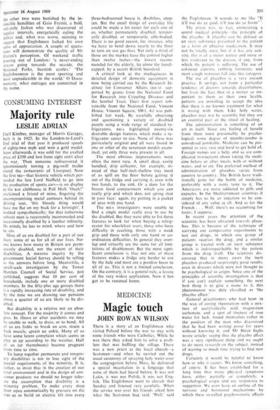CONSUMING INTEREST
Majority rule
LESLIE ADRIAN
Cecil Kimber, manager of Morris Garages, built it in 1925. In the London-to-Land's End trial of that year it produced speeds of eighty-two mph and won a gold medal. Soon afterwards it was sold for the exalted price of £350 and lost from sight until after the war. Then someone rediscovered it ignominiously towing a pig-swill trailer round the restaurants of Liverpool. Now the first mo—that historic vehicle which per- suaded the late Lord Nuffield to go into the production of sports cars—is on display at the aac clubhouse in Pall Mall. 'Ouch!' exclaimed a friend of mine, fingering the uncompromising metal contours behind its driving seat, 'this bloody thing would have me flat on my back for a fortnight'. I nodded sympathetically; for that (otherwise robust) man is recurrently incommoded and occasionally disabled by a lumbar infirmity. He minds, he has to mind, where and how he sits.
Most of us are disabled for a part of our lives; some of us for all of our lives. No- one knows how many in Britain are perm- anently disabled, nor the extent of their disabilities. A massive inquiry by the government Social Survey should be telling us the answers before long. Meanwhile, a small-scale investigation by the Tower Hamlets Council of Social Service, just published, suggests that 10 per cent of households include one or more disabled members. In the fifty-plus age groups there is a rapidly increasing rate of disability, and by the time we are drawing our pensions about a quarter of us are likely to be dis- abled.
But disability is a relative not an abso- lute concept. For the majority it comes and goes. In illness or after accidents we may be unable to walk, to dress, or to bend. All of us are liable to break an arm, strain a back muscle, sprain an ankle. Many of us have some latent complaint which seems to play us up according to the weather. Half of us (or thereabouts) become pregnant from time to time.
To lump together permanent and tempor- ary disabilities is not to lose sight of the special requirements of the minority. It is, rather, to insist that in the creation of our total environment and in the design of con- sumer products we should no longer toler- ate the assumption that disability is a minority problem. To make every shop door open automatically by pressure on the mat or to build an electric lift into every three-bedroomed house is. doubtless, utop- ian. But the small things of everyday life could be made a lot easier for each one of us, whether permanently disabled, tempor- arily disabled, or temporarily able-bodied. There is no good reason, for instance, why we have to bend down nearly to the floor to turn on our gas fires. Yet only a third of those on the market have the control higher than twelve inches—the lowest recom- mended for the elderly, let alone the handi- capped, by a recent British Standard.
A critical look at the inadequacies in detailed design of domestic equipment is now being carried out by the Research In- stitute for Consumer Affairs (RICA). sup- ported by grants from the National Fund for Research into Crippling Diseases and the Sembal Trust. Their first report (ob- tainable from the National Fund, Vincent House. Vincent Square, SWI, 4s) was pub- lished last week. By carefully observing and questioning a variety of disabled people using a wide range of standard re- frigerators, RICA highlighted twenty-six desirable design features which make a re- frigerator easier to use. None of these was particularly original and all were found in one or other of the seventeen models exam- ined; yet only three were present in all.
The most obvious improvements were often the most rare. A small deep, easily handled, drip collector, for example, in- stead of that half-inch-shallow tray most of us spill on the floor before getting it out of the fridge and carrying it, even with two hands, to the sink. Or a door for the frozen food compartment which you can really grip and which does not spring shut in your face: again, try putting in a packet of peas with one hand.
The RICA investigators were unable to find a single model really easy to use by the disabled. But they were able to list those features to look for when buying a refrig- erator for wheelchair users, those who have difficulty in reaching, those with a weak grip and those with only one hand or co- ordination difficulties. In general they over- lap and virtually are the same for all limi- tations of disablement. But the most signi- ficant conclusion is that not one of these features makes a fridge any harder to use by the hale and most are a positive boon to all of us. This is not a limited conclusion. On the contrary, it is a general rule, a lesson of the very widest application. Now it has got to be rammed home.


































 Previous page
Previous page